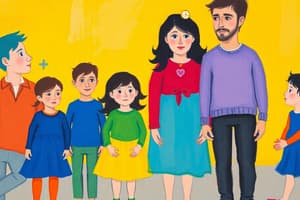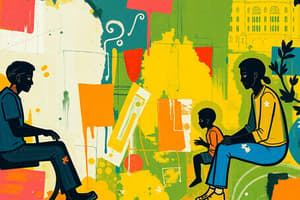Podcast
Questions and Answers
How do evolving divorce laws in Canada impact family dynamics, considering the principles of Life Course Theory?
How do evolving divorce laws in Canada impact family dynamics, considering the principles of Life Course Theory?
- They standardize family experiences, leading to more predictable life outcomes for children of divorced parents.
- They primarily reinforce traditional family structures by making divorce more difficult to obtain.
- They have minimal impact as family dynamics are solely determined by personal relationships.
- They introduce potential turning points and transitions that can alter individual and family trajectories. (correct)
In what ways might social media impact intimacy within families?
In what ways might social media impact intimacy within families?
- Social media has no effect on family intimacy as it is used mainly for external communications.
- Social media enhances intimacy by providing more opportunities for face-to-face communication.
- Social media may both strengthen connections through shared experiences and create distance through decreased in-person interactions. (correct)
- Social media exclusively undermines intimacy by promoting unrealistic expectations of relationships.
Considering Feminist Theory, how do social welfare policies such as parental leave and childcare support address gender inequality within families?
Considering Feminist Theory, how do social welfare policies such as parental leave and childcare support address gender inequality within families?
- These policies reinforce traditional gender roles by primarily benefiting women.
- These policies have no impact on gender equality as they do not address workplace discrimination.
- These policies increase gender inequality by creating a dependency on government assistance.
- These policies can alleviate some burdens disproportionately carried by women, promoting a more equitable distribution of labor and opportunities. (correct)
What implications does the increase in common-law unions and single-person households have for social policies?
What implications does the increase in common-law unions and single-person households have for social policies?
How does the Immigration Act of 1978 impact family reunification, considering the potential challenges immigrants face?
How does the Immigration Act of 1978 impact family reunification, considering the potential challenges immigrants face?
Which of the following best describes the sociological significance of studying family structures?
Which of the following best describes the sociological significance of studying family structures?
How do legal definitions of family primarily affect individuals and relationships?
How do legal definitions of family primarily affect individuals and relationships?
A couple chooses to remain childless due to career aspirations and financial considerations. Which type of family does this best represent?
A couple chooses to remain childless due to career aspirations and financial considerations. Which type of family does this best represent?
What is the central idea behind the Family Systems Theory in understanding family dynamics?
What is the central idea behind the Family Systems Theory in understanding family dynamics?
Which scenario best exemplifies Symbolic Interactionism's approach to understanding family dynamics?
Which scenario best exemplifies Symbolic Interactionism's approach to understanding family dynamics?
How does Ecological Theory enhance the understanding of family dynamics?
How does Ecological Theory enhance the understanding of family dynamics?
What characterizes the gender roles within hunter-gatherer families?
What characterizes the gender roles within hunter-gatherer families?
A family consisting of a mother, her daughter, the mother's brother, and his children living together represents which type of family structure?
A family consisting of a mother, her daughter, the mother's brother, and his children living together represents which type of family structure?
How did the shift from pre-industrial to urban industrial family structures primarily affect the roles of men and women?
How did the shift from pre-industrial to urban industrial family structures primarily affect the roles of men and women?
Which approach to cultural difference involves adopting the dominant culture's norms while diminishing one's original cultural identity?
Which approach to cultural difference involves adopting the dominant culture's norms while diminishing one's original cultural identity?
An immigrant family is well-qualified for professional occupations but experiences difficulty securing employment due to a lack of recognition for their international credentials. Which concept does this scenario best illustrate?
An immigrant family is well-qualified for professional occupations but experiences difficulty securing employment due to a lack of recognition for their international credentials. Which concept does this scenario best illustrate?
In the context of forming relationships, which factor is most closely associated with intimacy?
In the context of forming relationships, which factor is most closely associated with intimacy?
According to exchange theory, how do individuals evaluate relationships?
According to exchange theory, how do individuals evaluate relationships?
In contrast to the historical classic model of marriage, what does the choice model primarily emphasize?
In contrast to the historical classic model of marriage, what does the choice model primarily emphasize?
How have economic factors and medical advancements influenced family size trends?
How have economic factors and medical advancements influenced family size trends?
How do parents adhering to an authoritative parenting style typically behave?
How do parents adhering to an authoritative parenting style typically behave?
How does parental modeling influence the socialization of gender roles in children?
How does parental modeling influence the socialization of gender roles in children?
Which factor is most likely to increase a family's resilience when facing stressful situations?
Which factor is most likely to increase a family's resilience when facing stressful situations?
What was a major change introduced by the 1985 amendment to Canada's Divorce Act?
What was a major change introduced by the 1985 amendment to Canada's Divorce Act?
Which of the following is considered an experiential issue that can contribute to divorce?
Which of the following is considered an experiential issue that can contribute to divorce?
How might premarital cohabitation increase the risk of divorce, according to some studies?
How might premarital cohabitation increase the risk of divorce, according to some studies?
From a structural functionalist perspective, what role does marriage primarily serve?
From a structural functionalist perspective, what role does marriage primarily serve?
Considering exchange theory, how might the perceived costs of a relationship contribute to its dissolution?
Considering exchange theory, how might the perceived costs of a relationship contribute to its dissolution?
Flashcards
Legal Definition of Family
Legal Definition of Family
Families defined legally through marriage, common-law unions, and lone-parent households, influencing rights and responsibilities.
Social Definition of Family
Social Definition of Family
Families defined by emotional bonds, financial support, and daily interactions beyond legal ties. Includes chosen families.
Nuclear Family
Nuclear Family
Two parents and their children living together.
Single Parent Family
Single Parent Family
Signup and view all the flashcards
Extended Family
Extended Family
Signup and view all the flashcards
Blended Family
Blended Family
Signup and view all the flashcards
Same-Sex Family
Same-Sex Family
Signup and view all the flashcards
Foster/Adoptive Family
Foster/Adoptive Family
Signup and view all the flashcards
Feminist Theory (Families)
Feminist Theory (Families)
Signup and view all the flashcards
Life Course Theory (Divorce)
Life Course Theory (Divorce)
Signup and view all the flashcards
Immigration Act of 1978
Immigration Act of 1978
Signup and view all the flashcards
Social Welfare Policies
Social Welfare Policies
Signup and view all the flashcards
Future Family Trends
Future Family Trends
Signup and view all the flashcards
Racialization
Racialization
Signup and view all the flashcards
Integration
Integration
Signup and view all the flashcards
Assimilation
Assimilation
Signup and view all the flashcards
Intimacy
Intimacy
Signup and view all the flashcards
Commitment
Commitment
Signup and view all the flashcards
Exchange Theory
Exchange Theory
Signup and view all the flashcards
Filter Theory
Filter Theory
Signup and view all the flashcards
Authoritarian
Authoritarian
Signup and view all the flashcards
Authoritative
Authoritative
Signup and view all the flashcards
Permissive
Permissive
Signup and view all the flashcards
Resilience
Resilience
Signup and view all the flashcards
Economic Hardships
Economic Hardships
Signup and view all the flashcards
Social Stressors
Social Stressors
Signup and view all the flashcards
Structural Functionalism
Structural Functionalism
Signup and view all the flashcards
Exchange theory
Exchange theory
Signup and view all the flashcards
Study Notes
- Families can be legally recognized through marriage, common-law unions, and lone-parent households.
- Legal definitions of families affect rights and responsibilities like inheritance, custody, and tax benefits.
- Social definitions encompass emotional bonds, financial support, and daily interactions.
- Social definitions include chosen families, close friendships, and communal living arrangements.
Types of Families
- Nuclear families consist of two parents and their children living together.
- Single-parent families involve one parent raising one or more children.
- Extended families include relatives beyond the nuclear family.
- Blended families are formed through remarriage, with step-parents and step-siblings.
- Childless families are couples without children.
- Same-sex families have parents of the same gender
- Foster/Adoptive families are formed through fostering or adopting children.
Trends in Canadian Families
- There is a decline in marriage rates in Canada.
- Cohabitation is becoming increasingly common
- Same-sex partnerships are on the rise.
- People are marrying and having children later.
- After increases in the 1970s and 1980s, divorce rates have stabilized.
- There is an increase in blended and multiracial families.
Theoretical Perspectives
- Functionalism states that families fulfill societal needs like protection and emotional well-being.
- Symbolic Interactionism emphasizes how family members create meanings through daily interactions.
- Family Systems Theory views the family as an interconnected system.
- Feminist Theories analyze gender relations and power distribution within families.
- Life Course Theory focuses on transitions over the lifespan.
- Ecological Theory considers how individuals are embedded within multiple social contexts.
Historical Overview
- Hunter-Gatherer families lived cooperatively for survival.
- Hunter-gatherer families had flexible gender roles and communal child-rearing.
- Agricultural families often consisted of extended family.
- Land ownership was central to the wealth and status of agricultural families.
- Pre-Industrial families functioned as economic units with a gendered division of labor.
- Urban Industrial families saw the emergence of nuclear families as work moved outside the home.
- Contemporary families are diverse, influenced by technology, globalization, and evolving gender roles.
Cultural Dynamics
- Racialization refers to socially constructed categories that influence family experiences.
- Cultural Heritage: Preserving traditions and identity within multicultural societies.
- Prejudice, Discrimination, and Systemic Racism affects access to resources and opportunities for families.
Approaches to Difference
- Integration involves blending cultures while maintaining unique identities.
- Assimilation means adopting the dominant culture's norms.
- Passing means concealing minority status to blend into the dominant group.
- Separation involves maintaining cultural distinctiveness by minimizing interaction with other groups.
- Marginalization results in exclusion from mainstream society.
Aboriginal and Immigrant Families in Canada
- Aboriginal families are experiencing rapid population growth.
- Aboriginal families face challenges related to colonialism and systemic inequalities.
- Immigrant families can face challenges in employment and cultural integration.
- The recognition of qualifications can be difficult for immigrant families.
- Immigration laws and policies impact immigrant families.
Forming Relationships
- Intimacy involves emotional closeness, trust, and vulnerability.
- Commitment is a decision to maintain a relationship over time.
Types of Relationships
- Romantic relationships range from casual dating to long-term commitments.
- Platonic relationships are non-romantic and include friendships and familial bonds.
- Singlehood is increasingly accepted as a lifestyle choice.
Dating and Mate Selection
- Dating functions as status, socialization, recreation, and a precursor to marriage.
- Exchange Theory states that relationships are evaluated based on costs and benefits.
- Filter Theory uses proximity, attraction, and compatibility to determine relationships.
Marriage
- Marriage is seen as a social institution, legal status, and in some cultures, a religious duty.
- Rights and Responsibilities include sexual access, financial support, and joint property.
Types of Marriage
- The historical classic model emphasizes economic partnership and societal duty.
- The Choice Model focuses on personal fulfillment and emotional connection.
- The Commitment Model prioritizes long-term stability and shared responsibilities.
Trends in Parenting
- A shrinking family size is influenced by economic factors, lifestyle choices, and medical advancements.
Parenting Styles
- Authoritarian parenting involves high demands and strict discipline with limited warmth.
- Authoritative parenting means high expectations balanced with support and communication.
- Permissive parenting is lenient with few demands.
Socialization and Gender Roles
- Parents influence gender norms and expectations through modeling and reinforcement.
- Roles of motherhood and fatherhood vary by culture and historical context.
Challenges in Parenting
- Economic hardships, stress, conflict, and divorce create challenges.
- Changing parental roles and impact of education, income, and employment affect development.
Sources of Stress
- Economic Hardships: Income disparities and job insecurity
- Social Stressors: Stigma and societal expectations
- Life Transitions: Events like marriage, parenthood, and retirement
- Conflict and Divorce: Emotional, social, and economic crises for families
Coping Mechanisms
- Resilience includes adaptive strategies like problem-solving and emotional regulation.
- Social Support: Community resources, extended family, and support groups can help families.
Divorce Trends in Canada
- 1968 Divorce Act: Fault-based divorce
- 1985 Amendment: No-fault divorce with marital breakdown
- Current trends: Joint applications and less stigma
Reasons for Divorce
- Fundamental issues like infidelity and abuse.
- Experiential issues such as marital dissatisfaction.
- Fertility issues: Infertility and child-rearing conflicts.
Risk Factors
- Age, education, stress, religion, and interracial marriage are risk factors.
- Premarital cohabitation can cause commitment issues.
Outcomes of Divorce
- Divorce can cause emotional, social, and economic crises.
- Divorce can cause children to have behavioral and emotional challenges.
Theoretical Perspectives
- Structural Functionalism views marriage as a contract.
- Exchange Theory weighs the costs versus benefits of staying married.
- Feminist Theory examines power dynamics and gender inequality in marriage.
- Life Course Theory views divorce as a transition affecting trajectories.
Social Policies Affecting Families
- The Immigration Act of 1978 set up family, humanitarian, and independent classes for immigration.
- Immigrants face challenges in employment, qualification recognition, and cultural integration.
- Divorce laws in Canada have had an evolution on family dynamics.
- Social welfare policies include parental leave, childcare support, and social safety nets.
- These policies influence family structures and child development.
- Advocacy and Social Justice: Role of social workers and policymakers
- Addressing inequality and discrimination in social systems
Emerging Family Structures
- Diverse Forms: Cohabitation, same-sex partnerships, intentional communities are becoming more apparent.
- Blended families, multiracial and transnational families are becoming more apparent.
- Online dating and social media influence intimacy.
- Virtual communication is used in maintaining family connections.
Societal Changes
- Economic pressures can have a large affect on families.
- Gender roles and work-life balance are always changing.
- Aging population and delayed parenthood are demographic shifts.
- There is an increase in common-law unions and single-person households.
- There is greater acceptance of diverse family forms.
- There must be policy adjustments to reflect changing family dynamics.
Studying That Suits You
Use AI to generate personalized quizzes and flashcards to suit your learning preferences.




